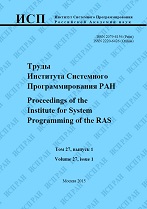|
This article is cited in 3 scientific papers (total in 3 papers)
Wireless integration to optimize environmental recognition and calculate the trajectory of a group of robots
M. V. Ivanov, O. Yu. Sergiyenko, V. V. Tyrsa, L. Lindner, J. C. Rodriguez-Quiñonez, W. Flores-Fuentes, M. Rivas-Lopez, D. Hernández-Balbuena, J. I. Nieto Hipólito
Universidad Autonoma de Baja California (UABC)
Abstract:
Nowadays artificial intelligence and swarm robotics become wide spread and take their approach in civil tasks. The main purpose of the article is to show the influence of common knowledge about surroundings sharing in the robotic group navigation problem by implementing the data transferring within the group. Methodology provided in article reviews a set of tasks implementation of which improves the results of robotic group navigation. The main questions for the research are the problems of robotics vision, path planning, data storing and data exchange. Article describes the structure of real-time laser technical vision system as the main environment-sensing tool for robots. The vision system uses dynamic triangulation principle. Article provides examples of obtained data, distance-based methods for resolution and speed control. According to the data obtained by provided vision system were decided to use matrix-based approach for robots path planning, it inflows the tasks of surroundings discretization, and trajectory approximation. Two network structure types for data transferring are compared. Authors are proposing a methodology for dynamic network forming based on leader changing system. For the confirmation of theory were developed an application of robotic group modeling. Obtained results show that common knowledge sharing between robots in-group can significantly decrease individual trajectories length.
Keywords:
robotic group, path planning, vision system, 3D laser scanner, network, data transferring.
Citation:
M. V. Ivanov, O. Yu. Sergiyenko, V. V. Tyrsa, L. Lindner, J. C. Rodriguez-Quiñonez, W. Flores-Fuentes, M. Rivas-Lopez, D. Hernández-Balbuena, J. I. Nieto Hipólito, “Wireless integration to optimize environmental recognition and calculate the trajectory of a group of robots”, Proceedings of ISP RAS, 31:2 (2019), 67–82
Linking options:
https://www.mathnet.ru/eng/tisp410 https://www.mathnet.ru/eng/tisp/v31/i2/p67
|

| Statistics & downloads: |
| Abstract page: | 130 | | Full-text PDF : | 27 | | References: | 19 |
|




 Contact us:
Contact us: Terms of Use
Terms of Use
 Registration to the website
Registration to the website Logotypes
Logotypes








 Citation in format
Citation in format 
